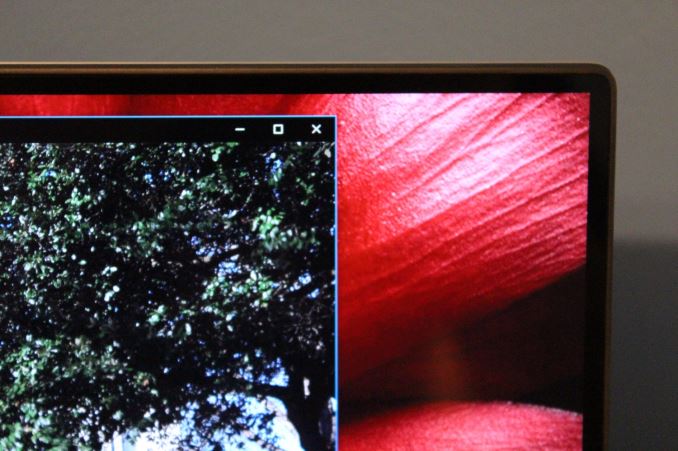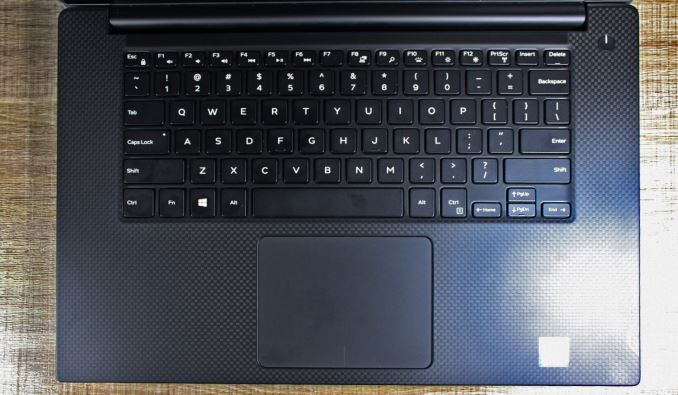The Dell XPS 15 9550 Review: Infinity Edge Lineup Expands
by Brett Howse on March 4, 2016 8:00 AM ESTDesign
There’s certainly some issues when competitors outright copy another’s design, but luckily for Dell they have one of the most appealing laptops already in the XPS 13. The XPS 15, other than the larger size, is extremely similar to its source of inspiration, and that’s a good thing. Moving to the Infinity Edge display brings the same strengths and weaknesses along with it, but the one thing you’d have a hard time knocking is the look of this laptop.
Dell uses CNC aluminum on the top and bottom of the laptop, which gives it that great cool feeling of metal when you are holding it in your hand. But open up the XPS 15, and you get to look at a soft touch carbon fibre weave which surrounds the keyboard deck. This soft touch material makes for a positive typing experience, and by going to black on the keyboard, Dell gets to avoid the contrast issues that happen on other machines with lighter colored keys. Although the laptop looks like a bit of a sandwich when its closed, I think the color scheme works very well and gives the XPS lineup a premium look.
The bottom of the laptop is as well thought out as the XPS 13. There’s a large vent for cooling, and the rubber feet are almost the entire width of the machine. There’s no issue with sliding around on a table top when you are using the XPS 15 thanks to these feet, and that’s not always something I can say about other laptops. It also gives you a nice stable platform in your lap. Another great XPS touch is that all of the FCC information, serial numbers, and other markings, are collectively put under an XPS badge on the bottom of the device to keep the look as clean as possible.
The left side of the laptop has the power connector, USB 3.0 Type-A port, HDMI, a USB 3.1 Gen 2 Type-C port which supports Thunderbolt 3 and power as well, and a headset jack. The right side has another USB 3.0 port, SD card slot, and a push button battery gauge. With the inclusion of USB 3.1 Gen 2 and Thunderbolt support there is a pretty big amount of bandwidth for any accessory, but as that market matures the USB Type-A connectors are likely going to see more use. It would have been nice to see a third USB port on the side but that’s a minor issue. Dell does sell a USB-C adapter which gives HDMI, VGA, Ethernet, and USB 3.0 all in one nice compact package which works well.
Once opened, the Infinity Edge display captures your eye, and the minimal bezel looks as good, or even better, than the smaller XPS 13. The webcam is still in a poor location though, tucked under the display and pointing up, which doesn’t flatter anyone. Considering the large bezel at the bottom of the display, I’d be fine with the screen shifting down slightly so the webcam could be fit above the screen, but I’m not a big user of a webcam so it’s not a big issue for me. If you do utilize a webcam a lot, this is not ideal and an external one might be better. I’d also like to see Windows Hello support in a premium machine such as this. Microsoft was able to fit it into the Surface Pro 4 and Surface Book with minimal bezels, so it can be done.
Taking a look at the keyboard, it’s very possible this is the exact same keyboard as on the XPS 13. It has the same white backlighting with high, low, and off settings, and the same layout as well. Dell didn’t try to squeeze a number pad into this 15.6-inch machine, and that’s a good thing since it would be very compromised with the smaller chassis this fits into. Key travel is 1.3 mm, which is adequate, and on the XPS 13 it was likely all that could be done thanks to the very thin body, but on the thicker XPS 15 I would have liked some more depth. The actuation force is also pretty light. The keyboard is ok but it’s not the best I’ve used, especially on a larger device.
Dell has gone with a Synaptics trackpad, and it is both very large and very smooth. Dell uses the Microsoft Precision Touchpad standard for their software, and although it lacks the outright customization of some of the other packages, in my time with the XPS 15 I found the touchpad to be excellent. The large size is very welcome, and it’s very precise while at the same time being very smooth. Two-finger scrolling works very well. There are not many options for three and four finger gestures with the Precision Touchpad, with three-finger tap opening Cortana, and four-finger tap opening Action Center. There are no other choices other than to swap those or disable it.
The overall design of the XPS 15 is as ground-breaking as the XPS 13 before it. By shrinking the bezels, Dell is able to fit a 15.6-inch device into a much smaller chassis, which makes it much more portable. The laptop itself is only 17 mm (0.66”) thick at its widest point (not including the feet) and weight with the 56 Wh battery is 1.78 kg (3.9 lbs) which is very light for a 15.6-inch machine. If you step up to the 84 Wh battery, that bumps the weight to 2 kg (4.4 lbs) which is still pretty respectable.















152 Comments
View All Comments
Hulk - Friday, March 4, 2016 - link
It's really not that hard. 1. Always use a tripod. 2. White balance when shooting (white card) or in PS. 3. Go full manual or aperture priority to get the exposure right, spot meter. 4. Shoot the sweet spot of every lens which is generally f/8. Again use the tripod and timer so you can deal with long exposures which will be necessary.It's not like you're shooting a moving kid or portrait.
Beany2013 - Saturday, March 5, 2016 - link
To be honest, the best way to get an amateur to take better photos is to hunt down a professional photographer and find out how much they'd charge for a consultation. Given that AT isn't a professional photography site, I'd wager most wouldn't mind not being the ones taking the photos, and would appreciate letting an interested amateur pick up some tips from the trade to improve their overall craft.I've been trying to get a semi-client of mine who operates a photobooth to do this for near three years now (I'm not a pro snapper so I don't feel I can teach him well enough) but he still doesn't do it - presumably, texting me is cheaper as I only charge in coffee and cake ;-)
But it's definitely worth a pop. Taking a usable photo is fine, taking a really nice, professional *looking* photo is very much it's own reward.
I agree with other commenters that the main meat of the article is definitely the words though; these photos might not be studio quality, but they're plenty clear enough for their purpose. Having them a bit nicer would be a bonus, and as a techy person and amateur snapper myself, I'm pretty certain Brett would enjoy learning how to bodge some nicer pics in - it's a lot of fun messing with this stuff with 'our' analytical kind of mindset.
Shadow7037932 - Saturday, March 5, 2016 - link
Here's the thing, you don't need $10k in gear to take good photos. You can get a refurb D3200/D3300 (~$330-350) with a fast standard zoom with good sharpness (Sigma 17-50 f2.8 OS HSM) for ~$300-350. Add in an off camera flash or two (~$60-70ea). Add in a CPL filter (~$50-60 for a good one) for dealing with reflections and a light box (~$40-50 for a large one) and you're all set.As far as white balance and other things goes, shoot RAW, and deal with it in post. Or do it in camera using the custom white balance.
nagi603 - Monday, March 7, 2016 - link
As someone who has invested into photography, you don't need 10k. Not even close. Frankly, your micron shot doesn't even have correct white balance. Fixing that would be a breeze if you shoot in RAW, use the same temperature lights, and used any post processing software. And yes, I've been there, I did shoot stuff as a journalist. Now I'm shooting events as a hobby, so I know what I'm talking about.tuxRoller - Sunday, March 6, 2016 - link
It's too bad the Verge doesn't spend as much time on article content.Brett Howse - Monday, March 7, 2016 - link
Photography is clearly not my strongest suit, but I've got some things I will try for the next review which I hope will help with the photos. Laptops are not the easiest thing for my to photograph and get a good result. Please bear with me as I try to step up my game on the images.trenchtoaster - Friday, March 11, 2016 - link
I have been reading AT for years now and this is the post which drove me to create an account and comment. I literally have no idea why the image you linked is any better than the ones from the article that you posted previously. What makes the image you linked so much better? I feel like I am missing somethingsircod - Friday, March 4, 2016 - link
I didn't notice it until you pointed it out, but that is pretty bad. Looks like he is shooting on a Canon EOS Rebel T4i, which apparently doesn't correct geometric distortion on its JPEGs.Brett Howse - Monday, March 7, 2016 - link
That's exactly what I am using, and apparently it does not. I, as an amateur photographer, did not even notice the distortion until it was pointed out, but I'll try to avoid it in the future.close - Monday, March 7, 2016 - link
You think someone buying a $1500+ laptop takes the decision based on how the pictures of the laptop look like on a website? Maybe people will assume the laptop is all bendy and with uneven color, right? I mean it's obvious they made one side of the laptop too bright and the other too dark.You go to a review site for he things you can't see in the store, not for some glamour shots. Yeah, of course they could be better but personally I don't think this subtracts anything from the value of the review.
Also going for the IQ argument because you think the picture looks bad makes you look even dumber than your idea that "people won't buy the laptop if the picture wasn't shot RAW".